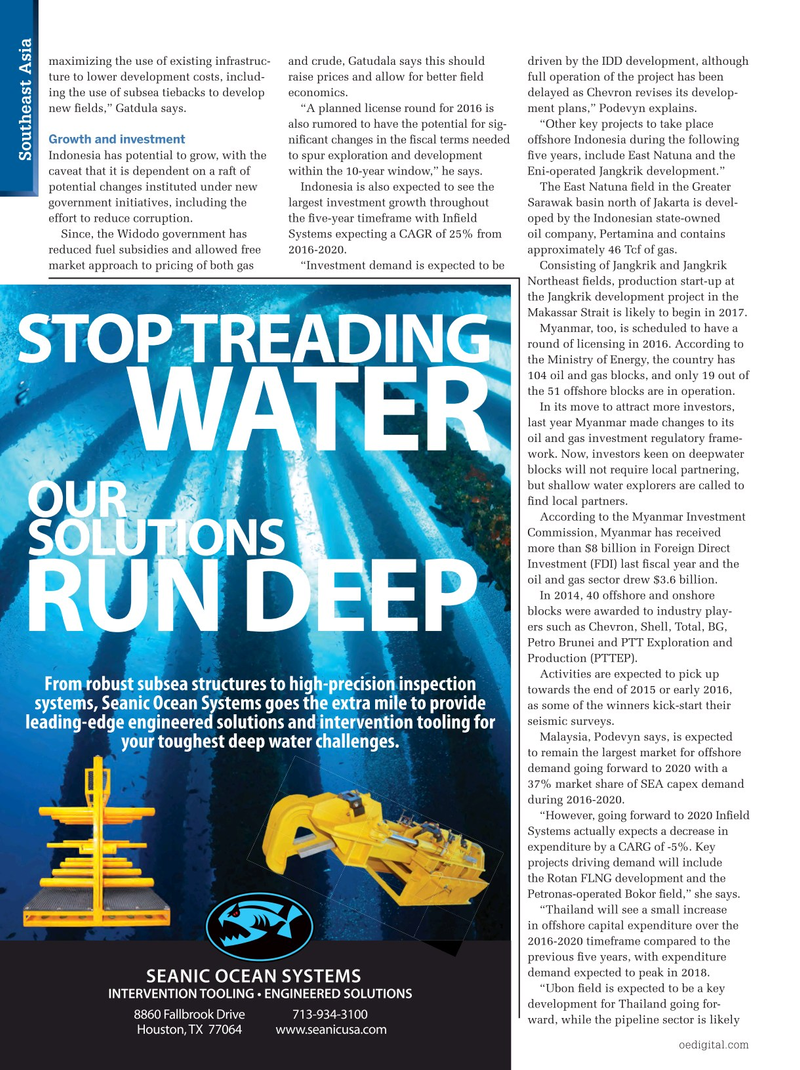
Page 50: of Offshore Engineer Magazine (Aug/Sep 2015)
Read this page in Pdf, Flash or Html5 edition of Aug/Sep 2015 Offshore Engineer Magazine
maximizing the use of existing infrastruc- and crude, Gatudala says this should driven by the IDD development, although ture to lower development costs, includ- raise prices and allow for better feld full operation of the project has been ing the use of subsea tiebacks to develop economics. delayed as Chevron revises its develop- new felds,” Gatdula says. “A planned license round for 2016 is ment plans,” Podevyn explains. also rumored to have the potential for sig- “Other key projects to take place
Growth and investment nifcant changes in the fscal terms needed offshore Indonesia during the following
Indonesia has potential to grow, with the to spur exploration and development fve years, include East Natuna and the
Southeast Asia caveat that it is dependent on a raft of within the 10-year window,” he says. Eni-operated Jangkrik development.” potential changes instituted under new Indonesia is also expected to see the The East Natuna feld in the Greater government initiatives, including the largest investment growth throughout Sarawak basin north of Jakarta is devel- effort to reduce corruption. the fve-year timeframe with Infeld oped by the Indonesian state-owned
Since, the Widodo government has Systems expecting a CAGR of 25% from oil company, Pertamina and contains reduced fuel subsidies and allowed free 2016-2020. approximately 46 Tcf of gas.
market approach to pricing of both gas “Investment demand is expected to be Consisting of Jangkrik and Jangkrik
Northeast felds, production start-up at the Jangkrik development project in the
Makassar Strait is likely to begin in 2017.
Myanmar, too, is scheduled to have a round of licensing in 2016. According to
STOP TREADING the Ministry of Energy, the country has 104 oil and gas blocks, and only 19 out of the 51 offshore blocks are in operation.
In its move to attract more investors, last year Myanmar made changes to its oil and gas investment regulatory frame-
WATER work. Now, investors keen on deepwater blocks will not require local partnering, but shallow water explorers are called to fnd local partners.
OUR
According to the Myanmar Investment
Commission, Myanmar has received more than $8 billion in Foreign Direct
SOLUTIONS
Investment (FDI) last fscal year and the oil and gas sector drew $3.6 billion.
In 2014, 40 offshore and onshore blocks were awarded to industry play- ers such as Chevron, Shell, Total, BG,
RUN DEEP
Petro Brunei and PTT Exploration and
Production (PTTEP).
Activities are expected to pick up
From robust subsea structures to high-precision inspection towards the end of 2015 or early 2016, as some of the winners kick-start their systems, Seanic Ocean Systems goes the extra mile to provide seismic surveys. leading-edge engineered solutions and intervention tooling for
Malaysia, Podevyn says, is expected your toughest deep water challenges.
to remain the largest market for offshore demand going forward to 2020 with a 37% market share of SEA capex demand during 2016-2020. “However, going forward to 2020 Infeld
Systems actually expects a decrease in expenditure by a CARG of -5%. Key projects driving demand will include the Rotan FLNG development and the
Petronas-operated Bokor feld,” she says.
“Thailand will see a small increase in offshore capital expenditure over the 2016-2020 timeframe compared to the previous fve years, with expenditure demand expected to peak in 2018.
SEANIC OCEAN SYSTEMS “Ubon feld is expected to be a key
INTERVENTION TOOLING • ENGINEERED SOLUTIONS development for Thailand going for- 8860 Fallbrook Drive 713-934-3100 ward, while the pipeline sector is likely
Houston, TX 77064 www.seanicusa.com oedigital.com 050_OE0815_Geofocus1_Raj.indd 52 7/21/15 9:56 PM

 49
49

 51
51